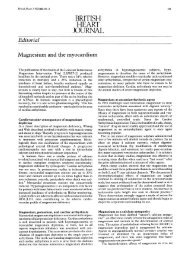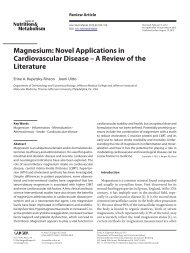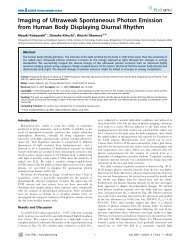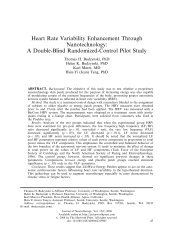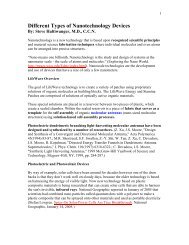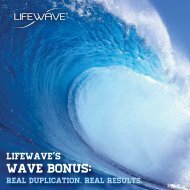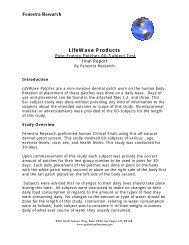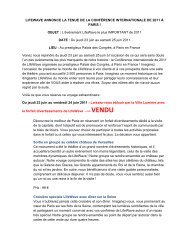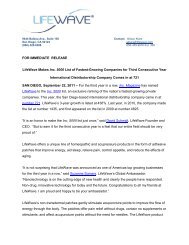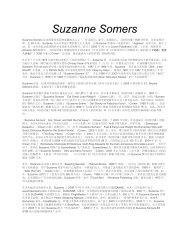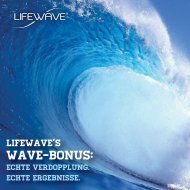A double blind placebo controlled study of the LifeWave technology ...
A double blind placebo controlled study of the LifeWave technology ...
A double blind placebo controlled study of the LifeWave technology ...
Create successful ePaper yourself
Turn your PDF publications into a flip-book with our unique Google optimized e-Paper software.
A <strong>double</strong> <strong>blind</strong> <strong>placebo</strong> <strong>controlled</strong> <strong>study</strong> <strong>of</strong> <strong>the</strong> <strong>LifeWave</strong> <strong>technology</strong> as it relates to <strong>the</strong><br />
improvement <strong>of</strong> strength endurance in high performance college athletics<br />
By David Schmidt, Richard Shaughnessy July 27, 2003<br />
Abstract<br />
The <strong>LifeWave</strong> <strong>technology</strong> is a new supplement and method for <strong>the</strong> improvement <strong>of</strong> athletic performance. <strong>LifeWave</strong><br />
is a means by which an individual may substantially increase <strong>the</strong>ir net strength endurance within as quickly as <strong>the</strong><br />
first use <strong>of</strong> <strong>the</strong> product. To evaluate this statement in an unbiased manner, a <strong>double</strong> <strong>blind</strong> <strong>placebo</strong> <strong>controlled</strong> <strong>study</strong><br />
was implemented at Troy State University in Troy, Alabama. The principal investigator <strong>of</strong> this <strong>study</strong> was Coach<br />
Richard Shaughnessy, strength and conditioning coach for <strong>the</strong> Troy State department <strong>of</strong> athletics. A standardized<br />
test was selected to measure net gains in strength endurance, and in this case <strong>the</strong> exercise that was performed by all<br />
athletes was a 225 lb. flat Bench Press. The baseline data for this test was collected on Thursday June 26, 2003.<br />
The comparative data was collected on <strong>the</strong> following Wednesday July 2, 2003. Athletes were divided into three<br />
groups: Control, Placebo and Test. The Control group was tested “as is” on both <strong>of</strong> <strong>the</strong>se testing days. The Placebo<br />
group was given a set <strong>of</strong> patches filled with water; this group was unaware as to whe<strong>the</strong>r or not <strong>the</strong> patches were real<br />
or water filled. The Test group was given a set <strong>of</strong> patches with <strong>the</strong> <strong>LifeWave</strong> <strong>technology</strong>; again, this group was<br />
unaware as to <strong>the</strong> contents <strong>of</strong> <strong>the</strong> patches. It will be emphasized that <strong>the</strong> athletes using <strong>the</strong> <strong>LifeWave</strong> <strong>technology</strong><br />
used <strong>the</strong> product only once; <strong>the</strong> test was performed within 10 minutes <strong>of</strong> first applying <strong>the</strong> patches to <strong>the</strong> athletes.<br />
Metabolism and ATP production<br />
It is well known that in humans in order for locomotion to occur ATP must be available to <strong>the</strong> muscle as well as all<br />
o<strong>the</strong>r cells. The biochemistry <strong>of</strong> metabolism is centered in <strong>the</strong> syn<strong>the</strong>sis <strong>of</strong> carbohydrates, fats, proteins and nucleic<br />
acids. For <strong>the</strong> purpose <strong>of</strong> this discussion we shall concern ourselves primarily with <strong>the</strong> metabolism, utilization and<br />
transport <strong>of</strong> fats as <strong>the</strong>y pertain to <strong>the</strong> production <strong>of</strong> ATP.<br />
In carbohydrate metabolism that involves <strong>the</strong> glycolysis <strong>of</strong> glucose molecules to pyruvic acid for <strong>the</strong> purpose <strong>of</strong><br />
feeding <strong>the</strong> Krebs Cycle with high-energy molecules, a process called chemiosmosis is used to pump protons across<br />
a membrane and provide <strong>the</strong> energy for ATP syn<strong>the</strong>sis. The electron carrying coenzyme molecules from <strong>the</strong> Krebs<br />
Cycle enter <strong>the</strong> chemiosmosis process, <strong>the</strong> electrons are lost from <strong>the</strong> coenzymes, <strong>the</strong> energy is used to pump<br />
protons across <strong>the</strong> mitochondrial membrane, and as <strong>the</strong> protons flow to <strong>the</strong> outer compartment <strong>of</strong> <strong>the</strong> mitochondrion<br />
<strong>the</strong> energy from <strong>the</strong> electron flow is used to syn<strong>the</strong>size ATP molecules.<br />
In contrast, in <strong>the</strong> metabolism <strong>of</strong> fats – precipitated by <strong>the</strong>se molecules being first broken down into fatty acids and<br />
glycerol molecules during digestion – <strong>the</strong> glycerol is converted within <strong>the</strong> cell to DHAP, an intermediary compound.<br />
This is important in that <strong>the</strong> DHAP may continue along a metabolic pathway to pyruvic acid, or <strong>the</strong> DHAP may<br />
reverse and follow ano<strong>the</strong>r pathway towards becoming glucose.<br />
Of concern in this discussion is <strong>the</strong> use <strong>of</strong> fatty acids as a metabolic reactant in <strong>the</strong> mitochondria <strong>of</strong> <strong>the</strong> cell. In a<br />
process known as beta-oxidation (<strong>the</strong> fatty acid spiral) <strong>the</strong> fatty acids are converted into 2-carbon units <strong>of</strong> acetyl-<br />
CoA. A single fatty acid molecule containing 16 carbon atoms will yield 8 molecules <strong>of</strong> acetyl-CoA. As each<br />
acetyl-CoA molecule enters <strong>the</strong> Krebs cycle it is metabolized to release its energy. The ultimate formation <strong>of</strong> ATP<br />
after beta-oxidation and <strong>the</strong> Krebs Cycle is <strong>the</strong> same as described above. The difference in <strong>the</strong> sources <strong>of</strong> energy –<br />
carbohydrates or fats – is in that <strong>the</strong> energy yield from a 16-carbon fatty acid molecule is considerable. With respect<br />
to an athlete, it would be highly desirable to be able to utilize fatty acids as an energy source in ATP production in<br />
that this could potentially have a desirable effect on stamina and/or strength endurance.
<strong>LifeWave</strong> principal <strong>of</strong> operation<br />
The <strong>LifeWave</strong> <strong>technology</strong> is a passive non-invasive device composed <strong>of</strong> water, Oxygen and organic compounds that<br />
is worn by <strong>the</strong> user much in <strong>the</strong> same fashion as a band aid. This product is not a transdermal patch and it has been<br />
demonstrated by <strong>the</strong> manufacturer that none <strong>of</strong> <strong>the</strong> patch active materials diffuses into or comes in contact with <strong>the</strong><br />
user.<br />
The obvious question that arises is how is it possible for such a device to function o<strong>the</strong>r than a <strong>placebo</strong> effect It is<br />
postulated by <strong>the</strong> manufacturer that <strong>the</strong> <strong>LifeWave</strong> patch passively modulates <strong>the</strong> oscillating low energy magnetic<br />
field that exists just above <strong>the</strong> surface <strong>of</strong> <strong>the</strong> human epidermal layer. This passive frequency modulation creates a<br />
condition in which <strong>the</strong> transport <strong>of</strong> long chain fatty acids across <strong>the</strong> mitochondrial membrane for subsequent betaoxidation<br />
and energy production is triggered or improved, <strong>the</strong>reby providing <strong>the</strong> user with increased energy via an<br />
increase in ATP production as described above.<br />
To understand how this phenomenon could be possible, let us re-examine <strong>the</strong> metabolic process involving fatty acid<br />
energy sources within <strong>the</strong> human body. Fatty acids, a hydrocarbon in which one <strong>of</strong> <strong>the</strong> hydrogen atoms has been<br />
replaced by a carboxyl group, are also described as a monobasic aliphatic acid made up <strong>of</strong> an alkyl radical attached<br />
to a carboxyl group. The metabolic role <strong>of</strong> fatty acids may be described in part in that fatty acids are one <strong>of</strong> <strong>the</strong><br />
primary sources <strong>of</strong> energy for humans, and through Beta-Oxidation, are broken down into basic units <strong>of</strong> energy. Of<br />
interest here is that in order for this process to work, fatty acids need to enter <strong>the</strong> mitochondria for Beta-Oxidation,<br />
and <strong>the</strong>y are unable to penetrate <strong>the</strong> inner mitochondrial membrane by <strong>the</strong>mselves.<br />
In addition to lipid metabolism, <strong>the</strong> mitochondria is involved with protein syn<strong>the</strong>sis, and by using ei<strong>the</strong>r phasecontrast<br />
microscopy or electron microscopy, <strong>the</strong> mitochondrial filaments or rods are seen to be 0.5 micrometers in<br />
diameter. This information is significant in that it is reported by <strong>the</strong> manufacturer that in <strong>the</strong> <strong>LifeWave</strong> <strong>technology</strong>,<br />
materials and structures must be selected based upon <strong>the</strong> resonant and sympa<strong>the</strong>tic frequencies <strong>of</strong> <strong>the</strong> mitochondria<br />
during lipid metabolism. In <strong>the</strong> human body, to overcome <strong>the</strong> problem <strong>of</strong> <strong>the</strong> inability <strong>of</strong> fatty acids to transport<br />
from <strong>the</strong> cytosol (soluble portion <strong>of</strong> <strong>the</strong> cell) across <strong>the</strong> mitochondrial membrane, it has been determined by several<br />
researchers that various nutrients are essential to transport long chain fatty acids from <strong>the</strong> cytosol across <strong>the</strong><br />
mitochondrial membrane for fatty acid oxidation/metabolism and energy production.<br />
To obtain <strong>the</strong> desirable effect <strong>of</strong> improving cell metabolism passively (specifically, increasing <strong>the</strong> rate <strong>of</strong> fatty acid<br />
Beta-Oxidation by allowing fatty acids to transport across <strong>the</strong> mitochondrial membrane) <strong>the</strong> manufacturer<br />
constructed a device consisting <strong>of</strong> orthomolecular organic structures designed to passively interact with <strong>the</strong> human<br />
magnetic field for <strong>the</strong> purpose <strong>of</strong> creating a system <strong>of</strong> frequency modulation, much in <strong>the</strong> same way that radio waves<br />
are modulated to communicate audio information.<br />
Context:<br />
At <strong>the</strong> time prior to <strong>the</strong> beginning <strong>of</strong> this <strong>study</strong> <strong>the</strong> relationship between <strong>the</strong> <strong>LifeWave</strong> <strong>technology</strong> and increases in<br />
stamina or strength endurance was known by <strong>LifeWave</strong> Products, LLC but not known by <strong>the</strong> athletes participating<br />
in this <strong>study</strong>.<br />
Objective:<br />
To quantitatively assess <strong>the</strong> effectiveness <strong>of</strong> <strong>the</strong> <strong>LifeWave</strong> <strong>technology</strong> in improving <strong>the</strong> bench press performance <strong>of</strong><br />
college football athletes during team training.<br />
Methods:<br />
Using a <strong>double</strong> <strong>blind</strong> randomized <strong>placebo</strong> <strong>controlled</strong> <strong>study</strong>, a total <strong>of</strong> 25 subjects, ages 18 to 22 years, volunteered to<br />
participate for this test <strong>study</strong>. Subjects’ baseline bench press data was colleted after a brief warm up period.<br />
Subjects were asked to bench press a fixed 225 lb. weight until failure. In <strong>the</strong> next session, subjects were<br />
randomized into three groups using a numbering system that labeled participants as test group, <strong>placebo</strong> group or<br />
control group members with 25 completing this two session <strong>study</strong>. The test group was provided with non-
transdermal patches that contained <strong>the</strong> <strong>LifeWave</strong> <strong>technology</strong>. The Placebo group was provided with nontransdermal<br />
patches that contained water. A collection team independent <strong>of</strong> <strong>the</strong> players collected and monitored<br />
data throughout <strong>the</strong> <strong>study</strong> process.<br />
Main Outcome Measures:<br />
The <strong>LifeWave</strong> <strong>technology</strong> is a non-invasive patch that demonstrated <strong>the</strong> ability to improve strength endurance in <strong>the</strong><br />
majority <strong>of</strong> athletes that utilized it during a strenuous weight lifting activity.<br />
Results:<br />
Raw data collected from <strong>the</strong> two-day <strong>study</strong> was as follows; all numbers listed are repetitions performed:<br />
CONTROL PLACEBO TEST<br />
Baseline Comparative ^Reps ^Percent Baseline Comparative ^Reps ^Percent Baseline Comparative ^Reps ^Percent<br />
10 10 0 0 23 23 0 0 3 8 +5 +166.7%<br />
4 6 +2 +50% 10 10 0 0 16 15 -1 -6.2%<br />
12 14 +2 +16.7% 7 12 +5 +71.4% 8 9 +1 +12.5%<br />
9 10 +1 +11.1% 21 24 +3 +14.3% 16 18 +2 +12.5%<br />
10 13 +3 +30% 14 8 -6 -42.8% 7 15 +8 +114.3%<br />
5 6 +1 +20% 10 11 +1 +10% 5 8 +3 +60%<br />
20 21 +1 +4.7% 26 27 +1 +3.8% 12 14 +2 +16.7%<br />
18 19 +1 +5.5% 11 17 +6 +54.5%<br />
6 5 -1 -16.7%<br />
18 11 -7 -38.9%<br />
From <strong>the</strong> raw data collected in <strong>the</strong> above table, and by removing <strong>the</strong> highest and lowest scores from each group, it<br />
was determined that (1) The average percentage change in strength endurance in <strong>the</strong> Control group was an increase<br />
in performance <strong>of</strong> 8.9% from <strong>the</strong> baseline tests to <strong>the</strong> comparative tests (average 0.875 rep improvement); (2) The<br />
average percentage change in strength endurance in <strong>the</strong> Placebo group was an increase in performance <strong>of</strong> 13.8%<br />
from <strong>the</strong> baseline tests to <strong>the</strong> comparative tests (average 1.67 rep improvement); (3) The average percentage change<br />
in strength endurance in <strong>the</strong> Test group was an increase in performance <strong>of</strong> 43.2% from <strong>the</strong> baseline tests to <strong>the</strong><br />
comparative tests (average 2.6 rep improvement).<br />
Average Percent Change In Strength Endurance<br />
50<br />
45<br />
40<br />
35<br />
30<br />
%Change<br />
25<br />
20<br />
15<br />
10<br />
5<br />
0<br />
1 2 3<br />
In addition, <strong>the</strong> data shows <strong>the</strong> following:
CONTROL GROUP PLACEBO GROUP TEST GROUP<br />
Decrease Same Increase Decrease Same Increase Decrease Same Increase<br />
2 1 7 1 2 5 1 0 6<br />
100%<br />
90%<br />
80%<br />
70%<br />
60%<br />
50%<br />
Increase<br />
Same<br />
Decrease<br />
40%<br />
30%<br />
20%<br />
10%<br />
0%<br />
1 2 3<br />
The above table gives us <strong>the</strong> breakdown <strong>of</strong> athletes in each group as it pertains to showing whe<strong>the</strong>r or not an athlete<br />
showed a decrease in performance from baseline to comparative test, remained <strong>the</strong> same in performance from<br />
baseline to comparative test, or showed an increase in performance from baseline to comparative test.<br />
In <strong>the</strong> Control group we see that 20% <strong>of</strong> <strong>the</strong> participants showed a decrease in performance during <strong>the</strong> two-day<br />
<strong>study</strong>, 10% <strong>of</strong> <strong>the</strong> participants maintained <strong>the</strong> same level <strong>of</strong> performance during <strong>the</strong> two-day <strong>study</strong>, and 70% <strong>of</strong> <strong>the</strong><br />
participants showed an increase in performance during <strong>the</strong> two-day <strong>study</strong>. In <strong>the</strong> Placebo group we see that 12.5%<br />
<strong>of</strong> <strong>the</strong> participants showed a decrease in performance during <strong>the</strong> two-day <strong>study</strong>, 25% <strong>of</strong> <strong>the</strong> participants maintained<br />
<strong>the</strong> same level <strong>of</strong> performance during <strong>the</strong> two-day <strong>study</strong>, and 62.5% <strong>of</strong> <strong>the</strong> participants showed an increase in<br />
performance during <strong>the</strong> two-day <strong>study</strong>. In <strong>the</strong> Test group we see that 14.3% <strong>of</strong> <strong>the</strong> participants showed a decrease in<br />
performance during <strong>the</strong> two-day <strong>study</strong>, 0% <strong>of</strong> <strong>the</strong> participants maintained <strong>the</strong> same level <strong>of</strong> performance during <strong>the</strong><br />
two-day <strong>study</strong>, and 85.7% <strong>of</strong> <strong>the</strong> participants showed an increase in performance during <strong>the</strong> two-day <strong>study</strong>.<br />
If we remove <strong>the</strong> data for <strong>the</strong> individuals who both decreased in performance and maintained <strong>the</strong> same level <strong>of</strong><br />
performance we find that (1) in <strong>the</strong> Control group, with respect to <strong>the</strong> 7 individuals who did show an improvement<br />
in performance from <strong>the</strong> baseline to <strong>the</strong> comparative test <strong>the</strong> average increase in strength endurance was 19.7%; (2)<br />
in <strong>the</strong> Placebo group, with respect to <strong>the</strong> 5 individuals who did show an improvement in performance from <strong>the</strong><br />
baseline to <strong>the</strong> comparative test <strong>the</strong> average increase in strength endurance was 30.8%; (3) in <strong>the</strong> Test group, with<br />
respect to <strong>the</strong> 6 individuals who did show an improvement in performance from <strong>the</strong> baseline to <strong>the</strong> comparative test<br />
<strong>the</strong> average increase in strength endurance was 63.8%.<br />
If we remove <strong>the</strong> data for <strong>the</strong> individuals who both increased in performance and maintained <strong>the</strong> same level <strong>of</strong><br />
performance we find that (1) in <strong>the</strong> Control group, with respect to <strong>the</strong> 2 individuals who decreased in performance<br />
from <strong>the</strong> baseline to <strong>the</strong> comparative test <strong>the</strong> average decrease in strength endurance was 27.8%; (2) in <strong>the</strong> Placebo<br />
group, with respect to <strong>the</strong> 1 individual who decreased in performance from <strong>the</strong> baseline to <strong>the</strong> comparative test <strong>the</strong><br />
decrease in strength endurance was 42.8%; (3) in <strong>the</strong> Experiment group, with respect to <strong>the</strong> 1 individual who<br />
decreased in performance from <strong>the</strong> baseline to <strong>the</strong> comparative test <strong>the</strong> decrease in strength endurance was 6.2%.
Discussion:<br />
Based on <strong>the</strong> data collected it is evident that <strong>the</strong>re are several distinct differences in athletic performance between<br />
<strong>the</strong> three groups. With respect to <strong>the</strong> simple averaging <strong>of</strong> performance numbers, it is not unusual that all three<br />
groups experienced an increase in strength endurance given <strong>the</strong> nature <strong>of</strong> <strong>the</strong> test (athletes were in a training session<br />
for <strong>the</strong> upcoming football season). With respect to <strong>the</strong> Placebo group, a case could be made that <strong>the</strong>re was indeed a<br />
“Placebo Effect” that took place; athletes that wore <strong>the</strong> patch product thought that <strong>the</strong>y had <strong>the</strong> real <strong>technology</strong> so<br />
hence <strong>the</strong>y made more <strong>of</strong> an effort to perform. Given <strong>the</strong> data <strong>of</strong> <strong>the</strong> average group performance improvement <strong>of</strong> <strong>the</strong><br />
Placebo group <strong>of</strong> 13.8% (as compared to 8.9% in <strong>the</strong> Control group) this would be a reasonable spread in terms <strong>of</strong><br />
attainable improvements from <strong>the</strong> baseline day to <strong>the</strong> comparative day. With respect to <strong>the</strong> Test group, <strong>the</strong>re was<br />
indeed a legitimate effect <strong>of</strong> <strong>the</strong> <strong>LifeWave</strong> <strong>technology</strong> on athletic performance; athletes that wore <strong>the</strong> patch product<br />
experienced an average improvement <strong>of</strong> 43.2% in strength performance. The spreads in average performance<br />
numbers between <strong>the</strong> three groups is significant and would tend to indicate that <strong>the</strong> <strong>LifeWave</strong> <strong>technology</strong> played an<br />
important role in improving strength endurance in <strong>the</strong> test group.<br />
Ano<strong>the</strong>r indicator that <strong>the</strong> <strong>LifeWave</strong> <strong>technology</strong> was having a legitimate effect on athletic stamina is evidenced in<br />
<strong>the</strong> chart on page 4. In all three groups we see that <strong>the</strong> majority <strong>of</strong> <strong>the</strong> athletes improved in performance; however,<br />
<strong>the</strong> Control group and Placebo group showed nearly identical percentages <strong>of</strong> athletes that improved, with 70% <strong>of</strong> <strong>the</strong><br />
Control group and 62.5% <strong>of</strong> <strong>the</strong> Placebo group. By comparison in <strong>the</strong> test group we see that 85.7% <strong>of</strong> <strong>the</strong><br />
participants experienced an improvement in performance. Given that <strong>the</strong> Test group had <strong>the</strong> highest percentage <strong>of</strong><br />
members who recorded an improvement in performance, with 85.7% <strong>of</strong> <strong>the</strong> members demonstrating an<br />
improvement, and that <strong>the</strong> average improvement was significantly higher than <strong>the</strong> o<strong>the</strong>r two groups (43.2%) this<br />
would again indicate that <strong>the</strong> <strong>LifeWave</strong> <strong>technology</strong> was having a beneficial effect on athletic performance.<br />
Ano<strong>the</strong>r important indicator with respect to examining that <strong>the</strong> <strong>LifeWave</strong> <strong>technology</strong> was having a beneficial effect<br />
on athletic performance is found when looking at only those individuals who increased in performance or only those<br />
individuals who decreased in performance. In <strong>the</strong> Control group we find that <strong>of</strong> those individuals who did show an<br />
improvement <strong>the</strong> average gain was 19.7%. In <strong>the</strong> Placebo group we find that <strong>of</strong> those individuals who did show an<br />
improvement <strong>the</strong> average gain was close to <strong>the</strong> Control group at 30.8%. In <strong>the</strong> Test group we find that <strong>of</strong> those<br />
individuals who did show an improvement <strong>the</strong> average gain was more than triple <strong>the</strong> Control group and <strong>double</strong> <strong>the</strong><br />
Placebo group at 63.8%. This information would indicate that <strong>the</strong> <strong>LifeWave</strong> <strong>technology</strong> was having a beneficial<br />
effect on strength endurance. This improvement is dramatic in that <strong>the</strong> individuals tested had only used <strong>the</strong><br />
<strong>LifeWave</strong> <strong>technology</strong> for 10 minutes prior to <strong>the</strong> test.<br />
Conclusion:<br />
Based on <strong>the</strong> data collected and <strong>the</strong> results obtained it was demonstrated that <strong>the</strong> <strong>LifeWave</strong> <strong>technology</strong> is a method<br />
for <strong>the</strong> improvement <strong>of</strong> athletic performance, and more particularly a means by which an individual may increase<br />
<strong>the</strong>ir net stamina/strength endurance output. The model utilized to evaluate <strong>the</strong> <strong>technology</strong> was a <strong>double</strong>-<strong>blind</strong><br />
<strong>placebo</strong> <strong>controlled</strong> <strong>study</strong>, with 25 college athletes from <strong>the</strong> Troy State University football team volunteering to<br />
participate in this <strong>study</strong>. In this evaluation <strong>of</strong> strength endurance involving competitive athletes both baseline and<br />
comparative tests were performed prior to any o<strong>the</strong>r type <strong>of</strong> physical activity. Being that <strong>the</strong> athletes had a very<br />
brief usage <strong>of</strong> <strong>the</strong> <strong>LifeWave</strong> <strong>technology</strong>, an additional <strong>study</strong> would prove to be <strong>of</strong> interest as a comparison to this<br />
test <strong>study</strong> to determine what effect <strong>the</strong> <strong>LifeWave</strong> <strong>technology</strong> has on athletes that incorporate <strong>LifeWave</strong> into <strong>the</strong>ir<br />
daily training regime.<br />
It was demonstrated that <strong>the</strong> Test/<strong>LifeWave</strong> group using <strong>the</strong> <strong>LifeWave</strong> <strong>technology</strong> showed <strong>the</strong> highest percentage <strong>of</strong><br />
improvement in strength endurance when averaging all members, <strong>the</strong> highest percentage <strong>of</strong> improvement in strength<br />
endurance when averaging only those members who showed an improvement, and <strong>the</strong> lowest percentage <strong>of</strong><br />
decreased performance when averaging only those individuals who showed a decline in performance.



